Decoding Anomalous Diffusion Using Higher-Order Spectral Analysis and Multiple Signal Classification
Abstract
1. Introduction
2. Fundamentals of Anomalous Diffusion
2.1. Annealed Transit Time Model (ATTM)
2.2. Continuous Time Random Walk (CTRW)
2.3. Fractional Brownian Motion (FBM)
2.4. Lévy Walk (LW)
2.5. Scaled Brownian Motion: SBM
3. Higher-Order Spectral Analysis: Bispectrum
3.1. Hybrid Algorithm: Multiple Signal Classification and Kurtosis
3.1.1. First Phase: Pseudospectrum Estimation Using the MUSIC Algorithm
- denotes the Hermitian transpose of the eigenvector . This operation involves taking the transpose of the matrix and applying the complex conjugate to each element. It is used in signal processing to perform orthogonal analysis of the signal components.
- represents the steering vector at frequency f, which describes the response of the system to a signal at that particular frequency. In the MUSIC algorithm, the steering vector helps evaluate how well the signal aligns with the subspace spanned by the eigenvectors.
3.1.2. Second Phase: Bispectral Analysis
4. Experimental Description
- For the ATTM and CTRW models, we considered 108 trajectories that represent the set of combinations of length, with , , and .
- For the LW model, we considered 108 trajectories that represent the set of combinations of length, with , , and .
- For the FBM and SBM models, we considered 210 trajectories that represent the set of combinations of length, with , , and .
5. Results Based on the Mean Value of Bispectrum
Histogram Analysis
6. Results Using the Hybrid Algorithm: Multiple Signal Classification and Kurtosis
7. Discussion
- With the use of both the bispectrum-based method and the method using multiple signal classification and kurtosis, it is possible to identify each of the anomalous diffusion trajectories analyzed.
- The method based on multiple signal classification and kurtosis gives better results than the method based on the mean value of the bispectrum in the task of differentiating the type of trajectory according to its sequence length.
- With the bispectrum-based method, better results are obtained to identify the type of trajectory based on the probability histogram or the distribution of the amplitude values. As a quantitative indicator of this, the obtained results from the correlation matrix in both cases are shown.
- The average amplitude values of the bispectrum follow an asymmetric probability distribution, which is common for all the trajectories analyzed in the experiments.
8. Conclusions
Author Contributions
Funding
Institutional Review Board Statement
Informed Consent Statement
Data Availability Statement
Acknowledgments
Conflicts of Interest
References
- Guigas, G.; Weiss, M. Sampling the cell with anomalous diffusion—The discovery of slowness. Biophys. J. 2008, 94, 90–94. [Google Scholar] [CrossRef]
- Klafter, J.; Sokolov, I.M. Anomalous diffusion spreads its wings. Phys. World 2005, 18, 29. [Google Scholar] [CrossRef]
- Shen, Z.; Plouraboué, F.; Lintuvuori, J.S.; Zhang, H.; Abbasi, M.; Misbah, C. Anomalous diffusion of deformable particles in a honeycomb network. Phys. Rev. Lett. 2023, 130, 014001. [Google Scholar] [CrossRef] [PubMed]
- Qiang, Y. Numerical Simulation of Anomalous Diffusion with Application to Medical Imaging. Ph.D. Thesis, Queensland University of Technology, Brisbane, Qld, Australia, 2013. [Google Scholar]
- Manzo, C.; Garcia-Parajo, M.F. A review of progress in single particle tracking: From methods to biophysical insights. Rep. Prog. Phys. 2015, 78, 124601. [Google Scholar] [CrossRef]
- Viswanathan, G.M.; Afanasyev, V.; Buldyrev, S.V.; Murphy, E.J.; Prince, P.A.; Stanley, H.E. Lévy flight search patterns of wandering albatrosses. Nature 1996, 381, 413–415. [Google Scholar] [CrossRef]
- Viswanathan, G.M.; Buldyrev, S.V.; Havlin, S.; da Luz, M.G.E.; Raposo, E.P.; Stanley, H.E. Optimizing the success of random searches. Nature 1999, 401, 911–914. [Google Scholar] [CrossRef]
- Sims, D.W.; Southall, E.J.; Humphries, N.E.; Hays, G.C.; Bradshaw, C.J.; Pitchford, J.W.; James, A.; Ahmed, M.Z.; Brierley, A.S.; Hindell, M.A.; et al. Scaling laws of marine predator search behaviour. Nature 2008, 451, 1098–1102. [Google Scholar] [CrossRef]
- Goiriz, L.; Ruiz, R.; Garibo-i Orts, Ò.; Conejero, J.A.; Rodrigo, G. A variant-dependent molecular clock with anomalous diffusion models SARS-CoV-2 evolution in humans. Proc. Natl. Acad. Sci. USA 2023, 120, e2303578120. [Google Scholar] [CrossRef]
- Longhi, S. Subdiffusive dynamics in photonic random walks probed with classical light. arXiv 2024, arXiv:2410.02287. [Google Scholar] [CrossRef]
- Alves-Pereira, A.R.; Nunes-Pereira, E.J.; Martinho, J.M.G.; Berberan-Santos, M.N. Photonic superdiffusive motion in resonance line radiation trapping partial frequency redistribution effects. J. Chem. Phys. 2007, 126, 154505. [Google Scholar] [CrossRef]
- Bouchaud, J.-P.; Georges, A. Anomalous diffusion in disordered media: Statistical mechanisms, models and physical applications. Phys. Rep.-Rev. Sec. Phys. Lett. 1990, 195, 127–293. [Google Scholar] [CrossRef]
- Sokolov, I.M.; Klafter, J. From diffusion to anomalous diffusion: A century after Einstein’s Brownian motion. Chaos 2005, 15, 26103. [Google Scholar] [CrossRef]
- dos Santos, M.A.F. Analytic approaches of the anomalous diffusion: A review. Chaos Solitons Fractals 2019, 124, 86–96. [Google Scholar] [CrossRef]
- Bo, S.; Schmidt, F.; Eichhorn, R.; Volpe, G. Measurement of anomalous diffusion using recurrent neural networks. Phys. Rev. E 2019, 100, 010102. [Google Scholar] [CrossRef]
- Firbas, N.; Garibo-i Orts, Ò.; Garcia-March, M.A.; Conejero, J.A. Characterization of anomalous diffusion through convolutional transformers. J. Phys. A-Math. Theor. 2023, 56, 014001. [Google Scholar] [CrossRef]
- Garibo-i Orts, Ò.; Baeza-Bosca, A.; Garcia-March, M.A.; Conejero, J.A. Efficient recurrent neural network methods for anomalously diffusing single particle short and noisy trajectories. J. Phys. A-Math. Theor. 2021, 54, 504002. [Google Scholar] [CrossRef]
- Garibo-i Orts, Ò.; Firbas, N.; Sebastiá, L.; Conejero, J.A. Gramian angular fields for leveraging pretrained computer vision models with anomalous diffusion trajectories. Phy. Rev. E 2023, 107, 034138. [Google Scholar] [CrossRef]
- Gentili, A.; Volpe, G. Characterization of anomalous diffusion classical statistics powered by deep learning (CONDOR). J. Phys. A-Math. Theor. 2021, 54, 314003. [Google Scholar] [CrossRef]
- Muñoz-Gil, G.; Garcia-March, M.A.; Manzo, C.; Martín-Guerrero, J.D.; Lewenstein, M. Single trajectory characterization via machine learning. New J. Phys. 2020, 22, 013010. [Google Scholar] [CrossRef]
- LeCun, Y.; Bengio, Y.; Hinton, G. Deep learning. Nature 2015, 521, 436–444. [Google Scholar] [CrossRef]
- Goodfellow, I.; Bengio, Y.; Courville, A. Deep Learning; MIT Press: Cambridge, MA, USA, 2016. [Google Scholar]
- Hochreiter, S.; Schmidhuber, J. Long short-term memory. Neural Comput. 1997, 9, 1735–1780. [Google Scholar] [CrossRef] [PubMed]
- Cho, K.; van Merrienboer, B.; Gulcehre, C.; Bahdanau, D.; Bougares, F.; Schwenk, H.; Bengio, Y. Learning phrase representations using RNN encoder-decoder for statistical machine translation. In Proceedings of the 2014 Conference on Empirical Methods in Natural Language Processing (EMNLP), Doha, Qatar, 25–29 October 2014; pp. 1724–1734. [Google Scholar]
- Rumelhart, D.E.; Hinton, G.E.; Williams, R.J. Learning representations by back-propagating errors. Nature 1986, 323, 533–536. [Google Scholar] [CrossRef]
- Graves, A.; Mohamed, A.; Hinton, G. Speech recognition with deep recurrent neural networks. In Proceedings of the 2013 IEEE International Conference on Acoustics, Speech and Signal Processing, Vancouver, BC, Canada, 26–31 May 2013; pp. 6645–6649. [Google Scholar]
- Krapf, D.; Marinari, E.; Metzler, R.; Oshanin, G.; Xu, X.; Squarcini, A. Power spectral density of a single Brownian trajectory: What one can and cannot learn from it. New J. Phys. 2018, 20, 023029. [Google Scholar] [CrossRef]
- Metzler, R. Brownian motion and beyond: First-passage, power spectrum, non-Gaussianity, and anomalous diffusion. J. Stat. Mech.-Theory Exp. 2019, 2019, 114003. [Google Scholar] [CrossRef]
- Sposini, V.; Metzler, R.; Oshanin, G. Single-trajectory spectral analysis of scaled Brownian motion. New J. Phys. 2019, 21, 073043. [Google Scholar] [CrossRef]
- Hinsen, K.; Kneller, G.R. Communication: A multiscale Bayesian inference approach to analyzing subdiffusion in particle trajectories. J. Chem. Phys. 2016, 145, 151101. [Google Scholar] [CrossRef]
- Thapa, S.; Lomholt, M.A.; Krog, J.; Cherstvy, A.G.; Metzler, R. Bayesian analysis of single-particle tracking data using the nested-sampling algorithm: Maximum-likelihood model selection applied to stochastic-diffusivity data. Phys. Chem. Chem. Phys. 2018, 20, 29018–29037. [Google Scholar] [CrossRef]
- Salzenstein, F.; Boudraa, A. Multidimensional directional derivatives and AM-FM dual-band image demodulation by higher order Teager-Kaiser operators. Digit. Signal Process 2022, 129, 103641. [Google Scholar] [CrossRef]
- Maraj, K.; Szarek, D.; Sikora, G.; Balcerek, M.; Wyłomańska, A.; Jabłoński, I. Measurement instrumentation and selected signal processing techniques for anomalous diffusion analysis. Meas. Sens. 2020, 7, 100017. [Google Scholar] [CrossRef]
- Vilk, O.; Aghion, E.; Nathan, R.; Toledo, S.; Metzler, R.; Assaf, M. Classification of anomalous diffusion in animal movement data using power spectral analysis. J. Phys. A-Math. Theor. 2022, 55, 334004. [Google Scholar] [CrossRef]
- Janczura, J.; Kowalek, P.; Loch-Olszewska, H.; Szwabiński, J.; Weron, A. Classification of particle trajectories in living cells: Machine learning versus statistical testing hypothesis for fractional anomalous diffusion. Phys. Rev. E 2020, 102, 032402. [Google Scholar] [CrossRef]
- Bellman, R. A markovian decision process. J. Math. Mech. 1957, 6, 679–684. [Google Scholar] [CrossRef]
- Iglesias-Martínez, M.E.; Antonino-Daviu, J.A.; Fernández de Córdoba, P.; Conejero, J.A. Higher-order spectral analysis of stray flux signals for faults detection in induction motors. Appl. Math. Nonlinear Sci. 2020, 5, 1–14. [Google Scholar] [CrossRef]
- Iglesias-Martínez, M.E.; Garcia-March, M.A.; Milián, C.; Fernández de Córdoba, P. Algorithms for Noise Reduction in Signals; IOP Publishing: Bristol, UK, 2022; pp. 2053–2563. [Google Scholar]
- Yang, X.; Wang, K.; Zhou, P.; Xu, L.; Liu, J.; Sun, P.; Su, Z. Ameliorated-multiple signal classification (Am-MUSIC) for damage imaging using a sparse sensor network. Mech. Syst. Signal Proc. 2022, 163, 108154. [Google Scholar] [CrossRef]
- Yang, X.; Wang, K.; Zhou, P.; Xu, L.; Su, Z. Imaging damage in plate waveguides using frequency-domain multiple signal classification (F-MUSIC). Ultrasonics 2022, 119, 106607. [Google Scholar] [CrossRef]
- Dokhanchi, S.H.; Mysore, B.S.; Mishra, K.V.; Ottersten, B. A mmWave automotive joint radar-communications system. IEEE Trans. Aerosp. Electron. Syst. 2019, 55, 1241–1260. [Google Scholar] [CrossRef]
- Joanes, D.N.; Gill, C.A. Comparing measures of sample skewness and kurtosis. J. R. Stat. Soc. Ser. D Stat. 1998, 47, 183–189. [Google Scholar] [CrossRef]
- Muñoz-Gil, G.; Volpe, M.A.; García-March, G.; Metzler, R.; Lewenstein, M.; Manzo, C. The anomalous diffusion challenge: Single trajectory characterisation as a competition. In Emerging Topics in Artificial Intelligence 2020; SPIE: Bellingham, WA, USA, 2020; Volume 11469, pp. 42–51. [Google Scholar]
- Muñoz-Gil, G.; Volpe, G.; Garcia-March, M.A.; Aghion, E.; Argun, A.; Hong, C.B.; Bland, T.; Bo, S.; Conejero, J.A.; Firbas, N.; et al. Objective comparison of methods to decode anomalous diffusion. Nat. Commun. 2021, 12, 6253. [Google Scholar] [CrossRef] [PubMed]
- Islam, M.A. Einstein–Smoluchowski diffusion equation: A discussion. Phys. Scr. 2004, 70, 120. [Google Scholar] [CrossRef]
- Islam, M.A. Fickian diffusion equation—An unsolved problem. Phys. Scr. 2004, 70, 114. [Google Scholar] [CrossRef]
- Sanvee, B.A.; Lohmann, R.; Horbach, J. Normal and anomalous diffusion in the disordered wind-tree model. Phys. Rev. E 2022, 106, 024104. [Google Scholar] [CrossRef]
- Glatt-Holtz, N.E.; Herzog, D.P.; McKinley, S.A.; Nguyen, H.D. The generalized Langevin equation with power-law memory in a nonlinear potential well. Nonlinearity 2020, 33, 2820. [Google Scholar] [CrossRef]
- Akimoto, T.; Yamamoto, E. Distributional behavior of diffusion coefficients obtained by single trajectories in annealed transit time model. J. Stat. Mech.-Theory Exp. 2016, 2016, 123201. [Google Scholar] [CrossRef]
- Massignan, P.; Manzo, C.; Torreno-Pina, J.A.; García-Parajo, M.F.; Lewenstein, M.; Lapeyre, G.J., Jr. Nonergodic subdiffusion from Brownian motion in an inhomogeneous medium. Phys. Rev. Lett. 2014, 112, 150603. [Google Scholar] [CrossRef]
- Scher, H.; Montroll, E.W. Anomalous transit-time dispersion in amorphous solids. Phys. Rev. B 1975, 12, 2455. [Google Scholar] [CrossRef]
- Napolitano, A. Cyclostationarity: Limits and generalizations. Signal Process 2016, 120, 323–347. [Google Scholar] [CrossRef]
- Mandelbrot, B.; Ness, J.W.V. Fractional Brownian motions, fractional noises, and applications. SIAM Rev. 1968, 10, 422. [Google Scholar] [CrossRef]
- Jeon, J.H.; Metzler, R. Fractional Brownian motion and motion governed by Langevin equation in confined geometries. Phys. Rev. E 2010, 81, 021103. [Google Scholar] [CrossRef] [PubMed]
- Klafter, J.; Zumofen, G. Lévy statistics in a Hamiltonian system. Phys. Rev. E 1975, 49, 4873. [Google Scholar] [CrossRef] [PubMed]
- Zaburdaev, V.; Denisov, S.; Klafter, J. Lévy walks. Rev. Mod. Phys. 2015, 87, 483. [Google Scholar] [CrossRef]
- Lim, S.C.; Muniandy, S.V. Self-similar Gaussian processes for modeling anomalous diffusion. Phys. Rev. E 2002, 66, 021114. [Google Scholar] [CrossRef]
- Fuliński, A. Anomalous diffusion and weak nonergodicity. Phys. Rev. E 2011, 83, 061140. [Google Scholar] [CrossRef]
- Jeon, J.-H.; Chechkin, A.V.; Metzler, R. Scaled Brownian motion: A paradoxical process with a time dependent diffusivity for the description of anomalous diffusion. Phys. Chem. Chem. Phys. 2014, 16, 15811–15817. [Google Scholar] [CrossRef]
- Marple, S.L., Jr. Digital Spectral Analysis with Applications; Prentice-Hall: Englewood Cliffs, NJ, USA, 1987. [Google Scholar]

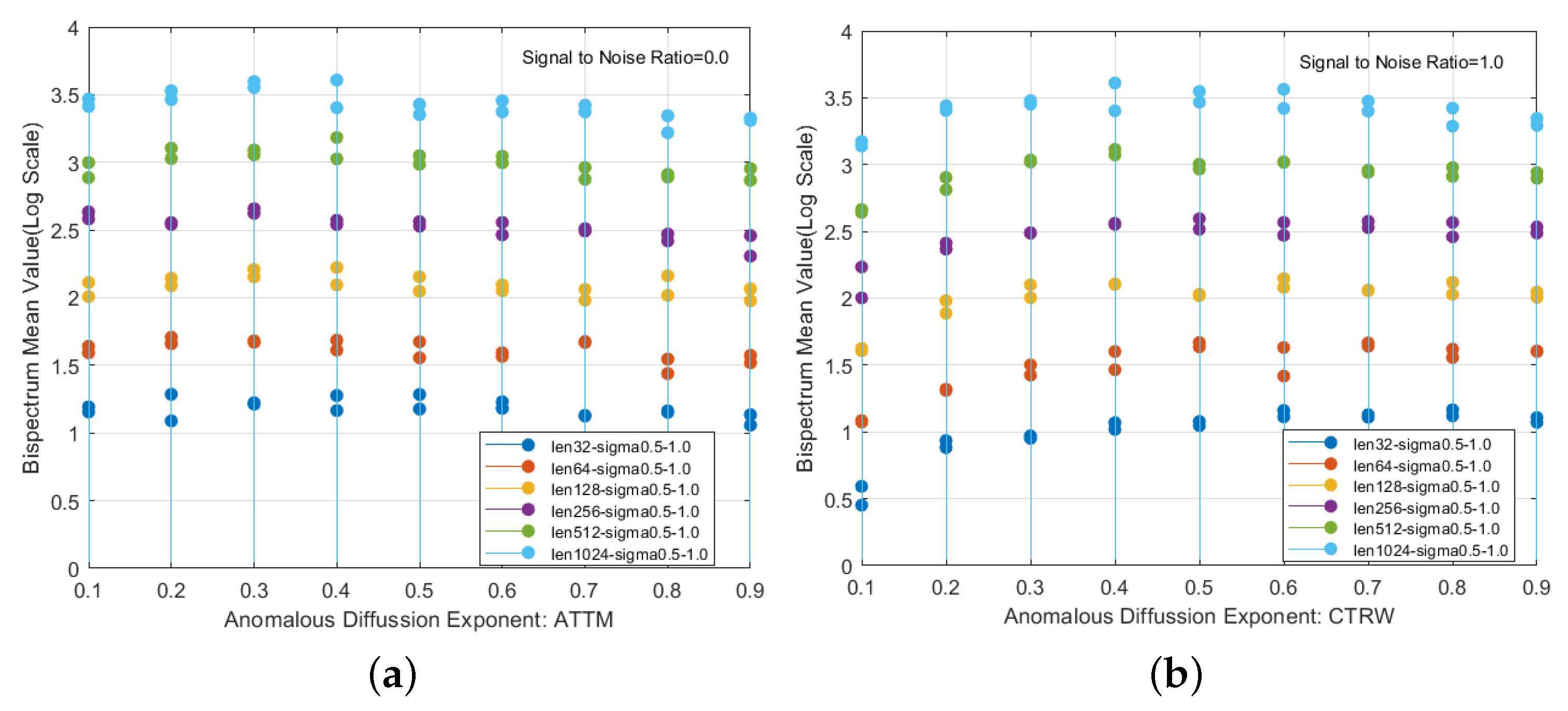

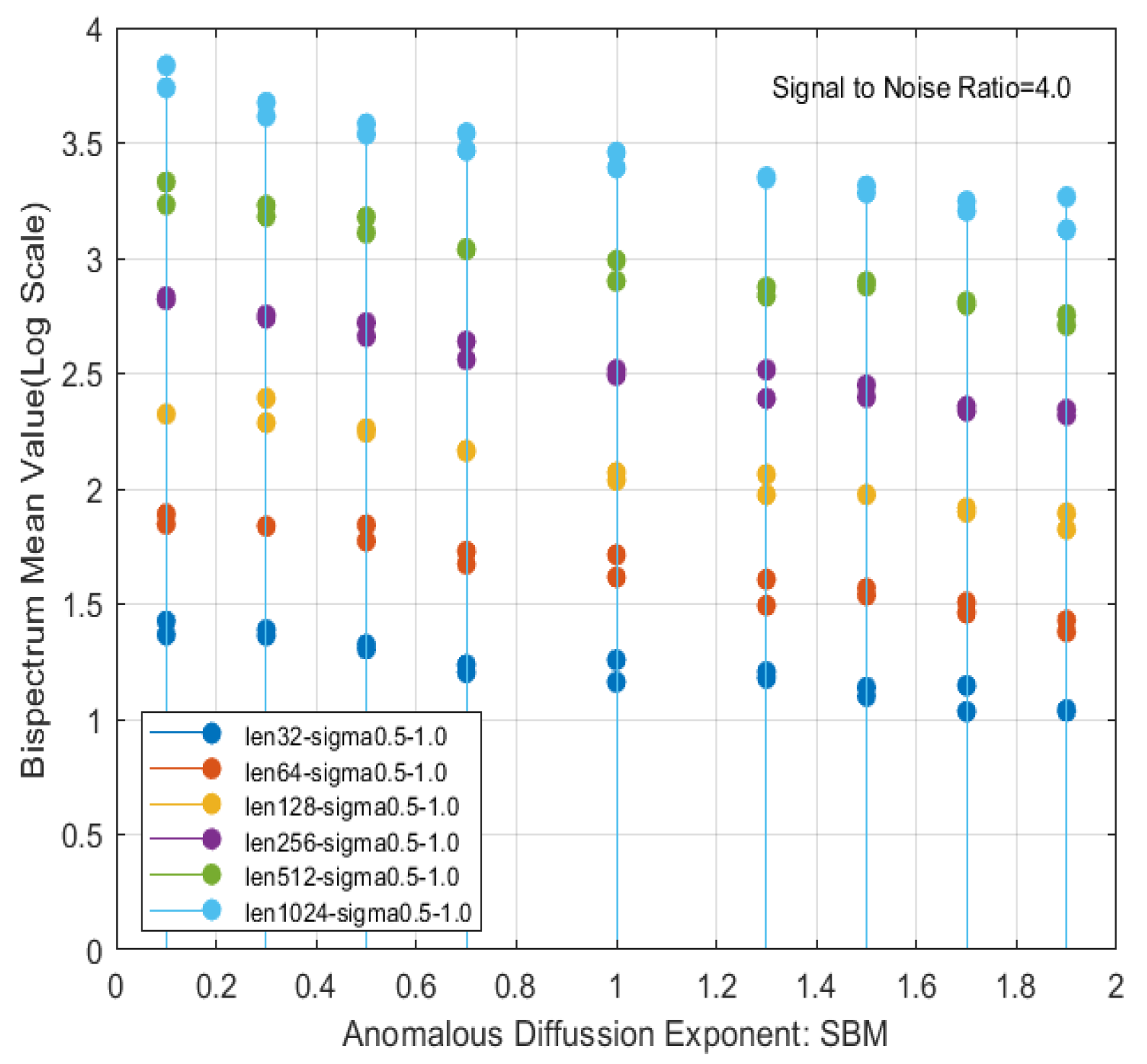

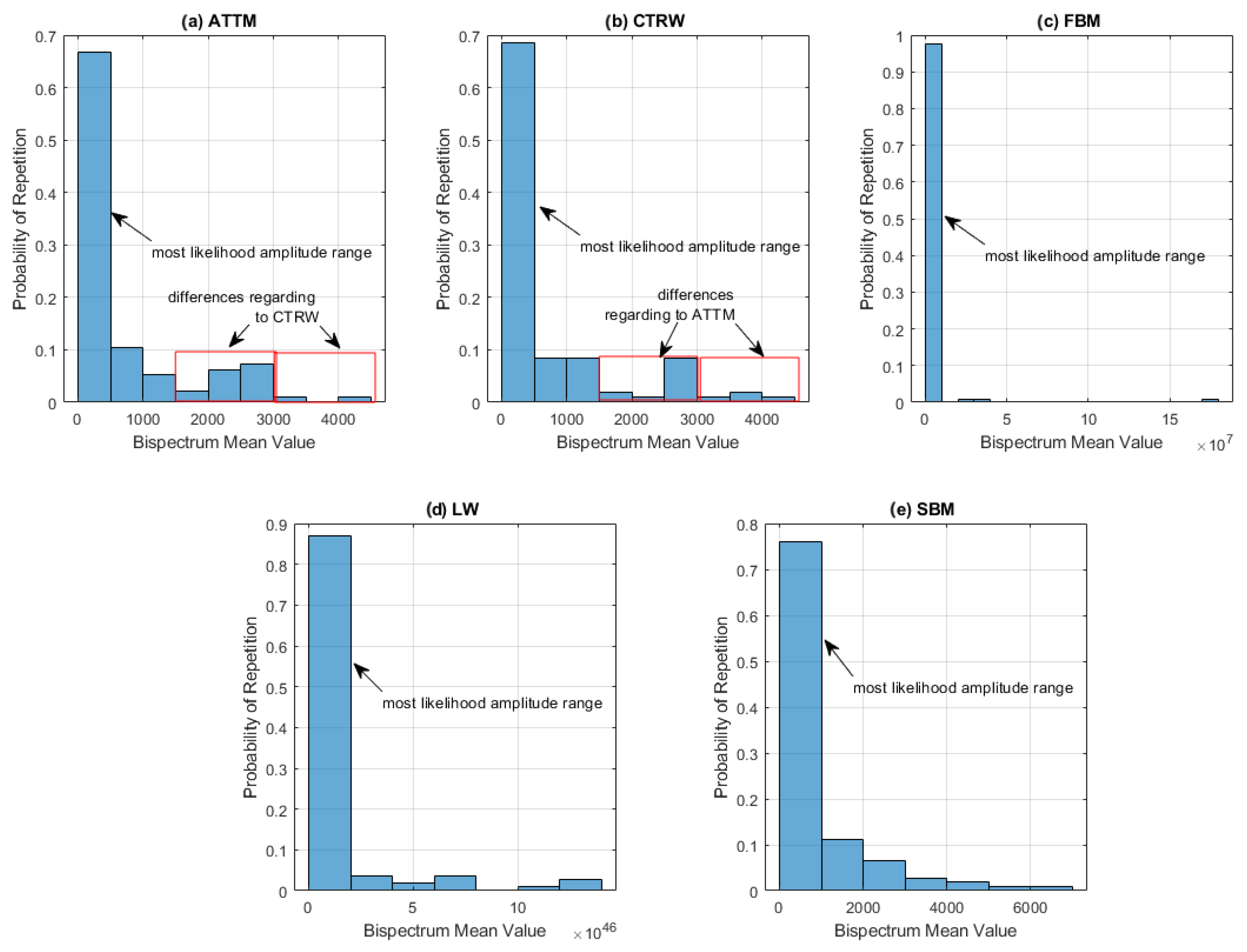


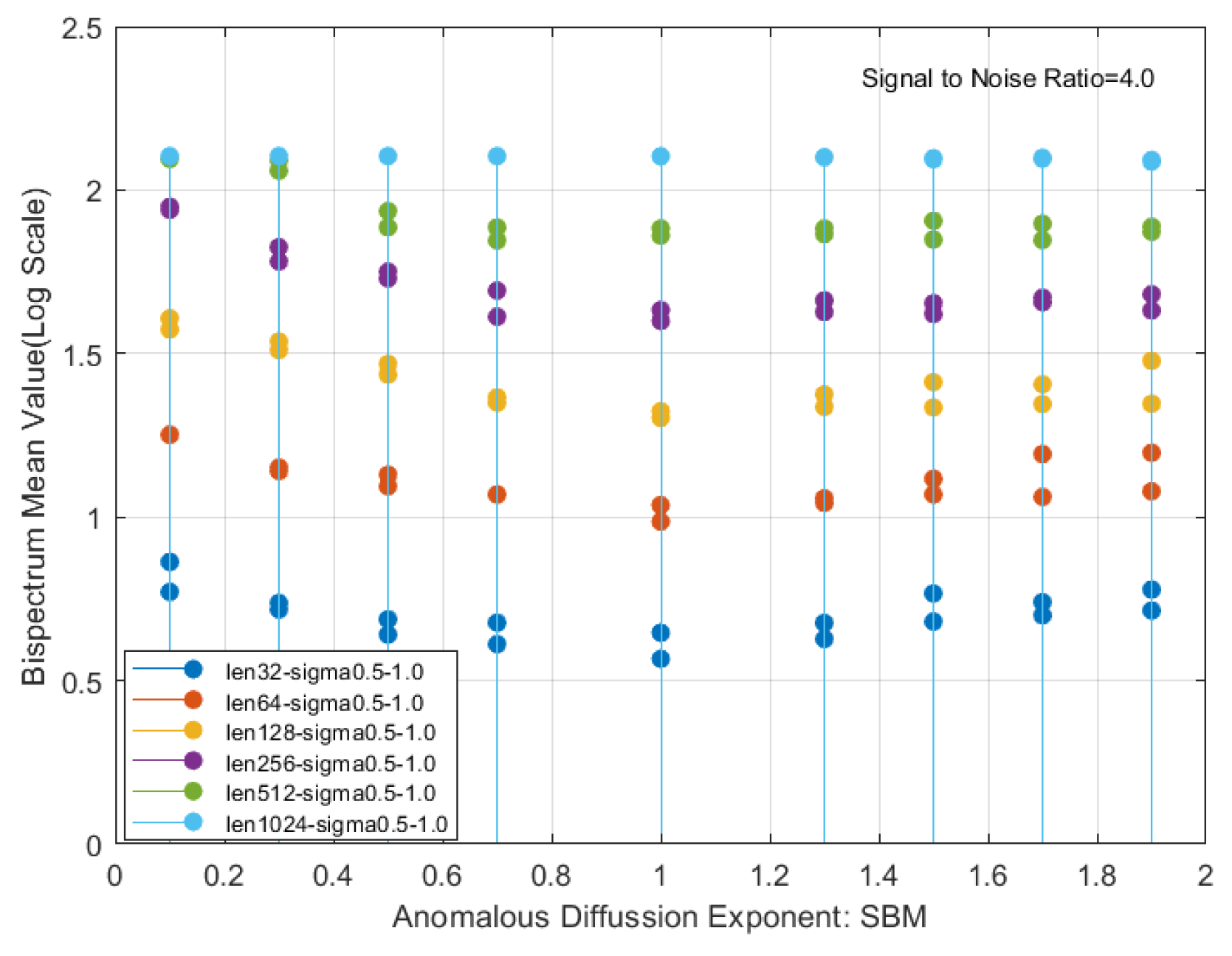

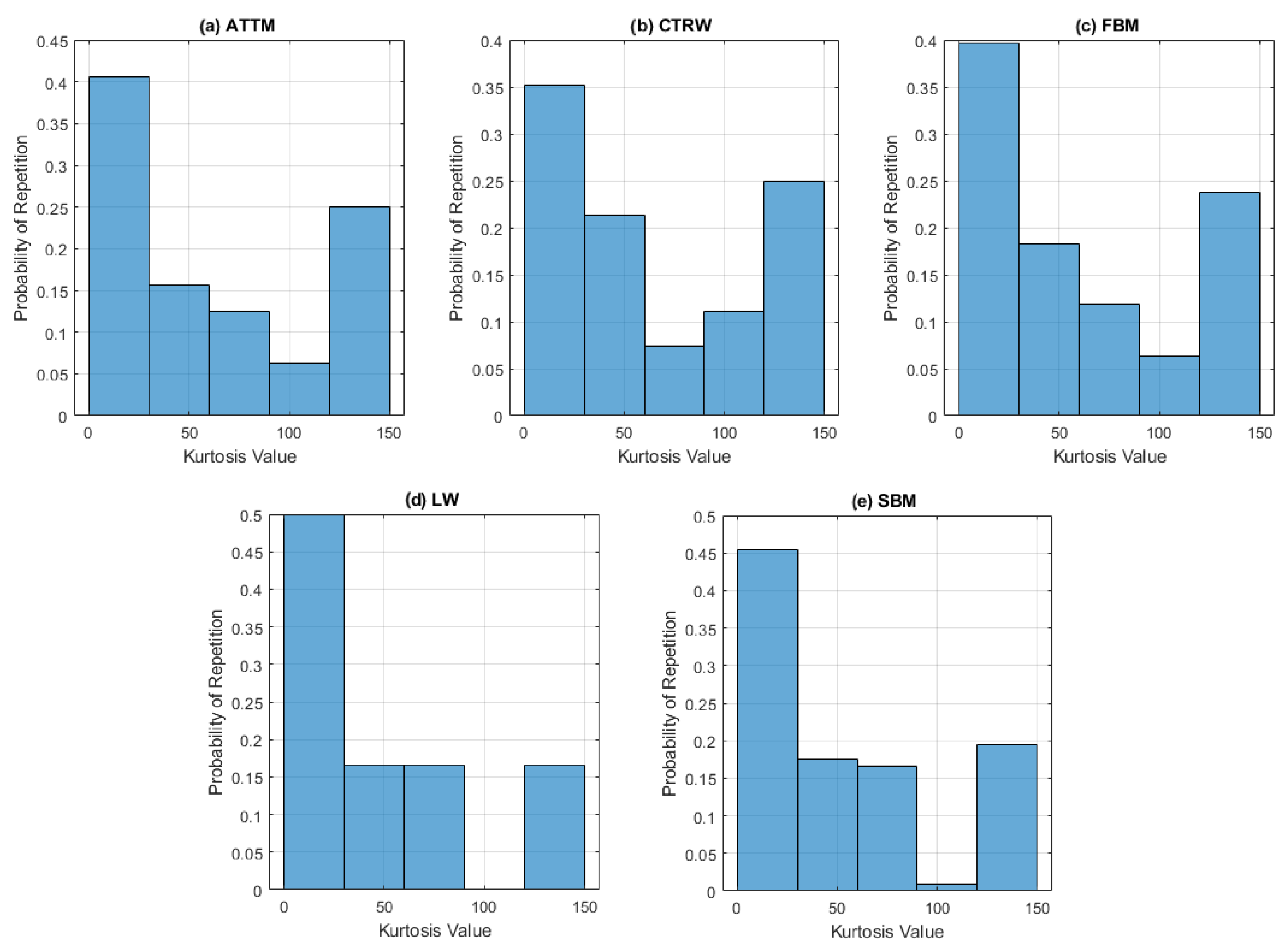
| ATTM | CTRW | FBM | LW | SBM | |
|---|---|---|---|---|---|
| ATTM | 1 | 0 | 0 | 0 | 0 |
| CTRW | 0.7499 | 1 | 0 | 0 | 0 |
| FBM | 0.1016 | 0.1958 | 1 | 0 | 0 |
| LW | −0.00616 | −0.2267 | −0.2390 | 1 | 0 |
| SBM | −0.2261 | 0.1144 | 0.8255 | 0.7841 | 1 |
| ATTM | CTRW | FBM | LW | SBM | |
|---|---|---|---|---|---|
| ATTM | 1 | 0 | 0 | 0 | 0 |
| CTRW | 0.8860 | 1 | 0 | 0 | 0 |
| FBM | 0.5676 | 0.6199 | 1 | 0 | 0 |
| LW | 0.5327 | 0.8880 | 0.8432 | 1 | 0 |
| SBM | 0.9426 | 0.5144 | 0.9553 | 0.8566 | 1 |
Disclaimer/Publisher’s Note: The statements, opinions and data contained in all publications are solely those of the individual author(s) and contributor(s) and not of MDPI and/or the editor(s). MDPI and/or the editor(s) disclaim responsibility for any injury to people or property resulting from any ideas, methods, instructions or products referred to in the content. |
© 2025 by the authors. Licensee MDPI, Basel, Switzerland. This article is an open access article distributed under the terms and conditions of the Creative Commons Attribution (CC BY) license (https://creativecommons.org/licenses/by/4.0/).
Share and Cite
Iglesias Martínez, M.E.; Garibo-i-Orts, Ò.; Conejero, J.A. Decoding Anomalous Diffusion Using Higher-Order Spectral Analysis and Multiple Signal Classification. Photonics 2025, 12, 145. https://doi.org/10.3390/photonics12020145
Iglesias Martínez ME, Garibo-i-Orts Ò, Conejero JA. Decoding Anomalous Diffusion Using Higher-Order Spectral Analysis and Multiple Signal Classification. Photonics. 2025; 12(2):145. https://doi.org/10.3390/photonics12020145
Chicago/Turabian StyleIglesias Martínez, Miguel E., Òscar Garibo-i-Orts, and J. Alberto Conejero. 2025. "Decoding Anomalous Diffusion Using Higher-Order Spectral Analysis and Multiple Signal Classification" Photonics 12, no. 2: 145. https://doi.org/10.3390/photonics12020145
APA StyleIglesias Martínez, M. E., Garibo-i-Orts, Ò., & Conejero, J. A. (2025). Decoding Anomalous Diffusion Using Higher-Order Spectral Analysis and Multiple Signal Classification. Photonics, 12(2), 145. https://doi.org/10.3390/photonics12020145






